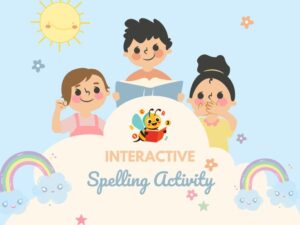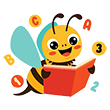INTERACTIVE SPELLING ACTIVITIES
Research suggests that providing children with simple terms, enjoyable activities on a daily basis improves their spelling skills and speed. Interactive spelling activity and collaborative tasks are more effective than worksheets, leading to increased confidence and attentiveness among students. Here are some spelling activities that you might want to attempt in your school.
Spelling Strategies and Activities
Students should be given interactive spelling activities to help them learn to spell. A list of suggested strategies is given at
the end of this booklet in the secondary section. Additional strategies could include:
- Rhyme – if they can spell mouse, they should be able to spell house
- Write the word with different coloured pens to break it into sections. This will help to teach
the pupils to learn to spell in ‘chunks’ rather than ‘letter by letter’ - Use different coloured post- its, one for each word. This will help pupils visualise the word when
they are trying to recall it. - Write the word in sand, finger paint etc –helps form memory hooks.
- Use big paper and big felt pens – not always a jotter.
- Chant the syllables eg Wed-nes-day, emphasizing the tricky bit. Use actions for each syllable.
- Draw a picture to help with a word eg big elephants can always understand small elephants = because
- Make the word into a picture eg bed could be drawn to look like a bed
1. Look, Cover, Write, Check – TRIOS
This is often the basic method used in classes but the expectation is that the pupil will be motivated
and be able to self teach. Mistakes are often written out three times and become embedded.
Try putting them in same ability trios. They check each others’ lists and then swap around again so the
checkers are checked! Alternatively, Interactive spelling activity shows the pupils the word, covers it and then the pupils write the word. The teacher would then show the word again for the pupils to check. Again this method has a higher success rate than when the pupils work as individuals.
2. Look, Cover, Write, Check – ‘SHOW ME’
Pupils work in pairs. Both pupils look at the same word. It is then covered and both pupils write the word
on an individual whiteboard. They then reveal their word – ‘one two three, show me’ and check that they
both have the same spelling. A quick activity that is very effective, It can also be done in trios or quartets.
3. FLASH CARDS
This is similar to the ‘show me’ activity above. Pupils quickly write out words on flash cards making sure
that they have the correct spellings. One reads aloud from a card and the other pupil writes the word
on a whiteboard. This time when they say ‘show me’, one shows the correct spelling on the card and the
other shows their attempt on the whiteboard. Pupils take turns reading or spelling.
4. DEFINITIONS
Make this exercise a more worthwhile learning experience by asking pupils to work in pairs. Pupils are
given one dictionary to share and work together to find and write the definition of each word. By using a
selection of dictionaries, pairs can then share and compare their definitions with another pair.
5. SPELLING ALOUD
Using flashcards, as above, one pupil reads a word aloud. Their partner spells the word out loud. If they
spell correctly, they ‘win’ the card. If they are wrong, the card is moved to the bottom of the pile. Pupils take turns and the ‘winner’ is the one who has most cards at the end of the game.
6. SPELLING TENNIS
You may have seen this one on the television programme ‘Hardspell’. Older children really enjoy this one
as it can be quite challenging. Pupils work in trios.
One takes on the role of both ‘reader’ and ‘checker’. The other two pupils spell the word by saying
alternative letters until the whole word is spelt. If a mistake is made, the checker stops the game and
shows them the correct spelling. Correct words are discarded. Pupils take turns to be the checker.
7. ALPHABETICAL ORDER
Pupils write out their spelling list in alphabetical order. This activity is best used with middle and upper
stage pupils but is particularly effective at making them look closely at the spelling of words that begin
with the same letter eg when learning common words. This could be an individual activity but, as a follow
up activity, pupils could work together to check they both have the same order.


